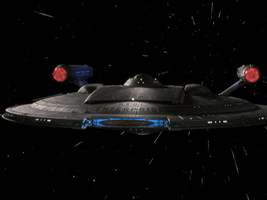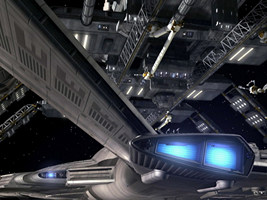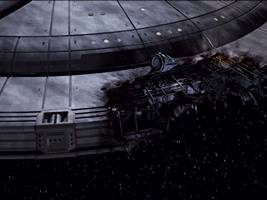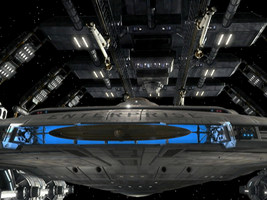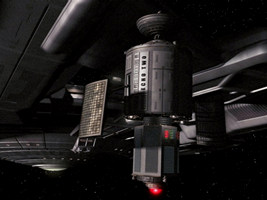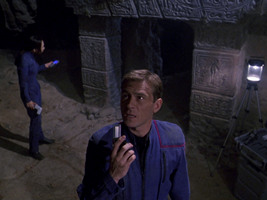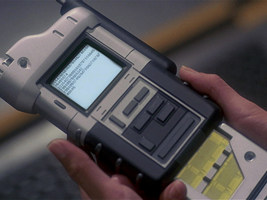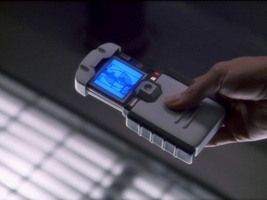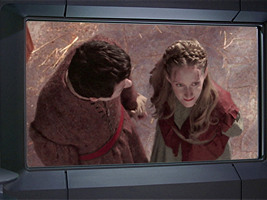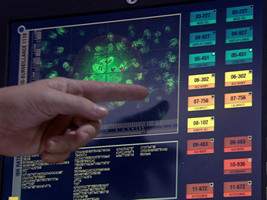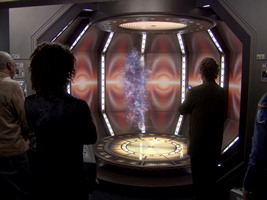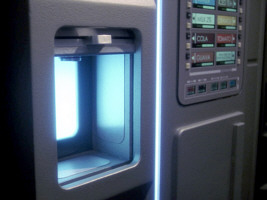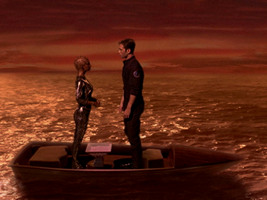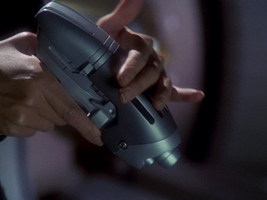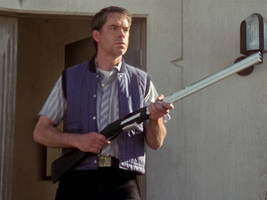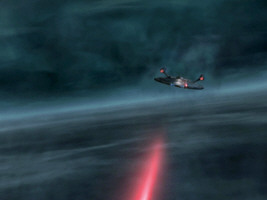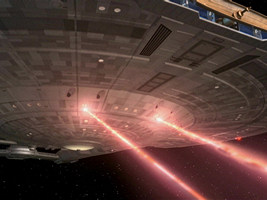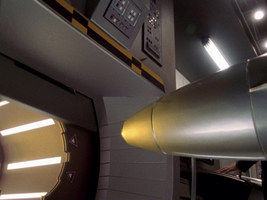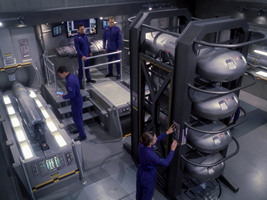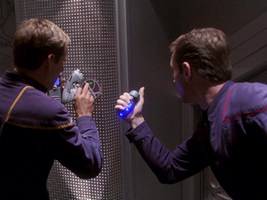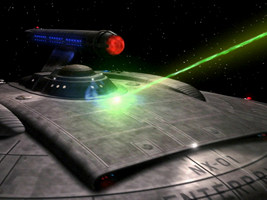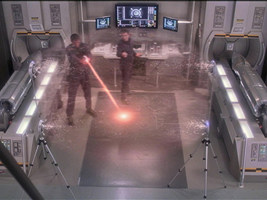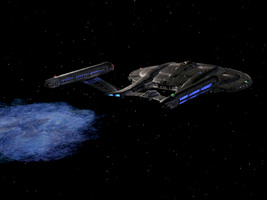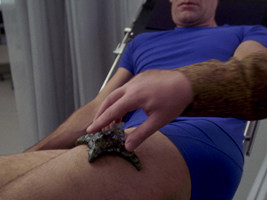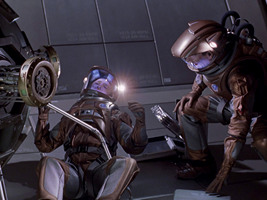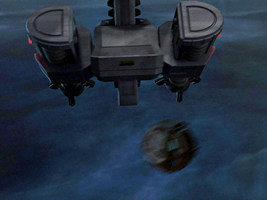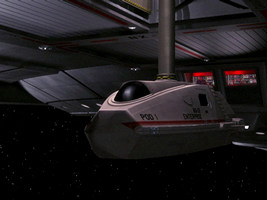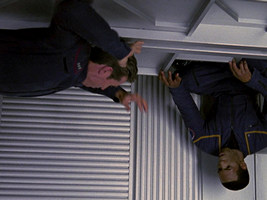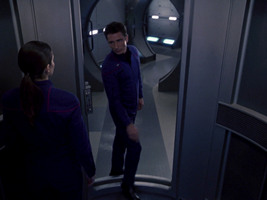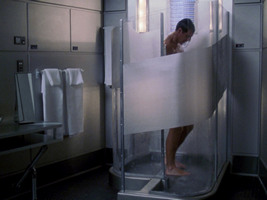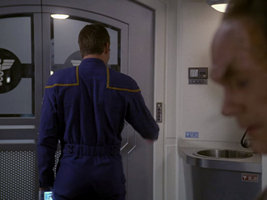A Close Look at 22nd Century Technology
Power & PropulsionComputers & CommunicationTransporter, Replicator & HolodeckWeaponsOther Technology
The setting of Star Trek Enterprise, 100 years prior to the so far recorded Star Trek in-universe history (TOS) and 200 years prior to the most recent style of the sets and visual effects (TNG, DS9, Voyager), poses problems of continuity to the future we already know from the other series. In particular, Enterprise requires a reasonably less advanced technology to be credible.
For one, this technology needs to be visually different. This doesn't necessarily mean it should look even more "primitive" than the sets and props used in The Original Series in the 60s. We may decide to attribute the coarse look of the TOS props to limited budget and VFX techniques. Moreover, we can't be sure which direction technical design may have taken from the 22nd to the 23rd century. The simplified look of TOS with less buttons and therefore less need for manual input may be taken as a sign of progress in some cases. However, at least with respect to the three 24th century series with their state-of-the-art visuals there should be a clearly perceptible de-evolution of props and sets in Enterprise, as well as a different look of special effects.
Aside from its look, the technology also needs to work differently and to be less powerful or less versatile. In particular, this would need to have an impact on the stories. It would allow (or necessitate) other plot constraints, owing to inferior technology that may not allow standard procedures like an emergency beam-out or a long-range scan over a distance of several light years. There are only few established facts about the 22nd century that would dictate precise limits of the technology of this era. In most cases it can be seen as a matter of extrapolation. It would appear very unlikely if all the familiar Star Trek technology were available as soon as 2151 and would not see any significant progress for the next 200 years. Considering that Earth Starfleet is supposed to be a newcomer in space, there may be more advanced technology in the hands of mysterious or hostile aliens, but only if it becomes plausible that their technology remains a secret for Starfleet.
This article studies the technology of the 22nd century, as established in Star Trek Enterprise, with regard to its continuity and plausibility.
Power & Propulsion
Warp core
The engine room set in TOS was very different from the familiar style we are used to since "Star Trek: The Motion Picture" (TMP). Although some TOS episodes suggest that dilithium is the fuel, we may presuppose that dilithium actually merely serves to control the matter/antimatter reaction as the true power source, as it is firmly established since TNG. If the power generation technology of Starfleet hasn't changed, we should assume that we have never seen the actual warp core on the Enterprise NCC-1701 prior to 2271. Scotty's familiar engine room is probably above the warp core, which would explain why the dilithium chamber is located there since the third season (as seen in TOS: "Elaan of Troyius"). Before that, there was a separate dilithium control room (TOS: "The Alternative Factor"). This would point to a complete refit of the warp core some time prior to 2268 (to be refurbished once again only two years later?).Trip Tucker confirms that his Enterprise's warp drive runs on a matter/antimatter (M/AM) reaction too (ENT: "Cold Front", "The Catwalk"). With regard to real physics, this would be the only viable power source. On the other hand, it is the same technology still used 200 years later. The difference is only quantitative, and not something that would cause more or other problems than we have already seen plenty of in nearly 600 previous Trek episodes. One difference seems to be that Enterprise's warp core or other crucial parts can't be jettisoned, because this would have been an option when the cascade reaction occurred in "Cold Front". If we consider Archer's complaints about the Vulcans holding back important technology (implying there was not much technological progress since humans developed warp drive), it could even make us believe that the matter/antimatter reactor as a technology and antimatter as the fuel were available for Cochrane's Phoenix as soon as 2063 - although Cochrane could hardly get his hands on comparably common materials like titanium to build his ship. An M/AM reactor in the Phoenix may indeed have been the producers' intention (if there was one), if we take into account that the probe Friendship One (VOY: "Friendship One"), launched in 2067, brought antimatter to an alien world. On the other hand, maybe the probe provided only a plan how to generate antimatter. For the sake of plausibility (in particular to explain why the ship is so much faster than any other Earth ship of the time), we should assume that Enterprise has the first human-built shipboard M/AM reactor.
Summarizing, the warp core on Enterprise NX-01 looks much unlike the one on the NCC-1701 and more like the ones in use since the late 23rd century. Since the look and principle of power generation is somewhat consistent since TMP, the problem is rather with TOS, and it may have been a good decision to go with the more recent TNG look if the technology is supposed to be essentially the same anyway. Good continuity is created in ENT: "The Catwalk", where it takes 20 minutes for a cold start of the warp core, which is about the same as in TOS: "The Naked Time". In "Divergence", on the other hand, Trip accomplishes the same in only two minutes.
But something else remains illogical in "Divergence": Wasn't the reason for the hassle in "Affliction" that the antimatter flow regulators couldn't be closed? In other words, the produced power would blow the warp core if the plasma didn't all go into the propulsion system. That's why Archer ordered Mayweather to go to maximum warp and later even in excess of that (Warp 5.2). Conversely, Tucker now (in "Divergence") insists that the reactor needs to be shut down and restarted after removing the Klingon virus while still at warp. As we can witness, after shutting down the reactor the warp field grille goes out almost immediately, meaning that no plasma is flowing through it any longer. If the antimatter regulators automatically go offline too, anything is fine. But in this case it wouldn't have needed Tucker to accomplish that and there would have been no hurry to restart the reactor. What's more, the warp core, especially when no plasma is flowing anyway, doesn't care whether a starship is at warp or not. If, however, the regulators were independent of the rest of the reactor or couldn't be closed because of the Klingon tampering (that's how it sounded like in "Affliction"), the ship would be destroyed in a huge matter-antimatter explosion the very instant the reactor goes offline. In either case the situation as shown in "Divergence" is inconsistent with "Affliction".
Warp drive
Enterprise NX-01 is built for a top speed of Warp 5. This equals 125c according to the TOS scale and 214c according to the TNG scale. Speed conversions in ENT: "Broken Bow" seem to confirm that the old TOS scale is used, whose warp factors are the third root of the v/c ratio. It is definitely much more plausible that the series uses the TOS scale, unless we want to explain that the scale changed twice (and even three times if we take into account the Warp 13 speed from TNG: "All Good Things"). If the TOS scale applies, this also gives the ship a lower top speed and leaves more of a development for the 100 years until TOS when the Enterprise NCC-1701 will achieve no more than Warp 6 (216c). The Mission of Enterprise NX-01 at Star Trek Dimension discusses the warp speeds of the 22nd century in more detail.The warp nacelles of Enterprise NX-01, unlike most of the rest of the ship, have a distinctive retro look. They fit in between the Phoenix and the original Enterprise NCC-1701. The nacelles are accessible while the warp core is inactive (ENT: "The Catwalk"). The plasma is visible like in 24th century nacelles and unlike on the original Enterprise, but I don't think this alone lets the NX-01 look too advanced. Since the technology of power generation hasn't changed, it is only logical that the plasma energy may be visible in the form of glowing nacelles. We may think of many reasons why the nacelles of the NCC-1701 were not glowing at all, and why those of the NCC-1701 refit and the Excelsior had only a faint gleam.
Rather on a side note, in "Twilight" we learn that with one nacelle left intact the ship is capable of reaching Warp 1.7 This supports the notion that nacelles are not entirely co-dependent.
A huge error on the part of the writers occurs in ENT: "Damage". Here Enterprise is in urgent need of a "warp coil" to get the warp engines operational again. The so-called "warp coil" turns out to be a single small component that is installed somewhere inside the ship. It has absolutely nothing in common with the true warp coils inside the nacelles as we know them from everywhere else in Star Trek and as they were explicitly mentioned and shown in VOY: "Nightingale". Obviously the idea came from the stupid "transwarp coil" from VOY: "Dark Frontier", but this sort of "continuity" is no excuse to make an even worse error. Moreover, since when can Enterprise simply use components from a completely unknown alien ship design? Even if Tucker had been familiar with their technology, it would most likely not have been possible to incorporate it. Rick Sternbach wrote about the "warp coil" at TrekBBS: "And what drives me nuts is how human-built stuff is readily interchangeable with alien stuff. I mean, crap, even metric spark plugs don't fit non-metric holes. And when you go overseas, you need a bagful of voltage convertors. Trek has hardly ever dealt well with the problems of interface adapters."
Regarding the question whether the Romulans had warp drive in the 22nd century, please refer to the extensive article Warp Drive and Romulan History.
Impulse drive
The principle of the impulse drive hasn't changed much in the past 200 years, as Geordi says in TNG: "Relics". Since this is obviously an approximate time, we could conjecture that the impulse drive of NX-01 was the first of a new kind. The size of the impulse drive exhaust, on the other hand, doesn't tell us anything about the level of technology. The size was moderate on the original Constitution, the Constitution refit and the Excelsior. The Enterprise-B had huge additional impulse exhausts, whereas the Ambassador, Galaxy and Intrepid use comparably tiny impulse drives. Still newer ships like the Sovereign have huge exhausts again. There is neither a clear tendency nor an evident reason why the sizes vary considerably.Rather than their sizes, it surprises that Enterprise NX-01 has four separate impulse exhausts (perhaps without a real intention but only because the Akira has them too), meaning that there have to be separate reactors too. The main engines appear to be the ones on the aft, while the saucer engines are probably just auxiliary devices. On one hand, this may be advantageous as it provides more redundancy. On the other hand, this complication of the design could entail unnecessary maintenance and repair efforts on this prototype where two engines may have sufficed.
Interesting information about the impulse drives comes from ENT: "E²". Here the impulse wake is supposed to cause the time travel, interacting with the subspace corridor. This indicates that there is more about the impulse engines than just an exhaust of hot gas. It is only plausible, considering that relativistic effects would need countermeasures, otherwise the ship could never reach a considerable fraction of c.
Thrusters
There is nothing necessarily advanced about a reaction control system. Its principle hasn't changed in essence from the Apollo spacecraft to the 24th century. The original Enterprise NCC-1701 lacked visible thrusters, although the ship should have had them too.Star Trek Enterprise does the only right thing and corrects this visual deficiency or inaccuracy of the original Enterprise in TOS by giving the NX-01 four blocks of thrusters at the edges of the saucer where they are traditionally located on all Starfleet vessels at latest since the Constitution refit. In ENT: "In a Mirror, Darkly", Archer mentions port, starboard and aft thrusters (although with "aft thrusters" he could have meant the impulse engines). Since the thrusters are just holes, there isn't any particular retro look to them. I could imagine they would have looked even better though, had they been nozzles sticking out from the surface.
Deflector
The deflector serves to generate a weak forcefield in front of the starship to sweep away interstellar particles that would otherwise penetrate the hull and possibly cause severe damage. We know of several starships like the Miranda and the Constellation without a visible deflector dish, but they can be supposed to have a field generator for this purpose too.It was a logical decision to give Enterprise NX-01 a visible deflector. As soon as in ENT: "Broken Bow", Reed points out its importance: "...if I don't realign the deflector, the first grain of space dust we come across will blow a hole through this ship the size of your fist." It is pleasant to note that, unlike it was the case since TNG: "Best of Both Worlds I" when the deflector evolved to a multi-purpose sensor/transmitter/weapon, the 22nd century deflector is not a plot-driven device. As for the look, the NX-01 deflector is a hybrid of the often ridiculed golden dish of the original Enterprise, backlit in blue like a TMP/TNG deflector. It is a bit odd that Enterprise combines both styles, because in TOS the unlit metallic dish was the actual device, whereas it was the blue area on the Enterprise refit, the Excelsior and the Enterprise-C.
Computers & Communication
Subspace radio
In TOS: "Balance of Terror" it was mentioned that the peace treaty between Earth and Romulus had been negotiated via subspace radio (audio only - to explain why the two races have never seen each other face to face). That was in 2161. Therefore, we know that subspace communication already existed in the 22nd century. On the other hand, as mentioned in TOS: "A Piece of the Action", the USS Horizon sent an EM distress call (i.e., at light speed) in 2167, which then took a hundred years until it was picked up. Either the Horizon was not yet equipped with a subspace transmitter (which may have been a bulky piece of equipment in those days), or the transmitter was simply destroyed in the accident. In VOY: "11:59", Harry talks of an ancestor whose ship was still without subspace transmitter in 2210. Maybe we can explain the statement in that it was a long-term mission (it was a sleeper ship), and in such a distance even subspace signals wouldn't have worked. On the other hand, why didn't the ship simply drop amplifiers? What's more, Harry's statement sounds as if subspace radio hadn't existed at all. Either he didn't get the date or the fact right, or we have a continuity error here.Subspace communication had finally become the standard during TOS and TNG, but its speed seemed to vary arbitrarily between real-time and days of delay, depending on what the plot required, rather than on the actual distance. Although not explicitly stated on screen, this is why the speed of a subspace signal, unlike the one of an EM signal that always travels at light speed, depends on the amplification and therefore on the technology level and the density of subspace relays, as explained in the TNGTM.
At the time of Enterprise, there are no subspace relays at all that could facilitate the communication between Enterprise and Earth. After all, Enterprise is the first ship to explore unknown regions of space "where no human has gone before". Archer mentions to Admiral Forrest in ENT: "Fortunate Son" that they will deploy a subspace amplifier (which they do in "Silent Enemy"), but this is only supposed "to clear up reception a bit". FTL communication, even real-time communication, is quite obviously possible without their help. The writer's guide for the series supposedly says that faster-than-light (FTL) communication should be feasible only at warp speed. But already in ENT: "Broken Bow" Enterprise transmits and receives FTL signals while in orbit around Qo'noS. On the other hand, even if only traveling at warp made FTL communication possible, this still wouldn't allow real-time communication. The speed of the ship may add to the speed of a subspace signal (as opposed to the relativistic addition of speeds), but a signal of little more than Warp 5 would still need weeks to reach Earth. And if FTL signals may be sent only from ships traveling faster than light, how should a message be transmitted from Earth to Enterprise? This dictates that, realistically, there should be no direct relation between FTL communication and warp flight. It seems to be only a problem of creating a strong enough subspace field to "submerge" the signal, no matter if the ship is currently at warp or not. We have to witness real-time communication between Enterprise and Earth without the slightest delay in ENT: "Fortunate Son". This would still require a speed of Warp 9.99something, even though the distance is supposedly only a few light years. Thus, since the speed of a subspace signal is a sign of the technology level, there is absolutely no progress until the 24th century.
Communicator
Basically, there is no reason why a simple cell phone shouldn't be much smaller and yet more powerful in the 22nd century or even the 23rd century than in our days. But the Starfleet communicators are more than that. They must have a subspace transmitter that allows FTL communication, even though many TOS episodes suggest that the range of the hand-held devices is limited to intra-system communication. In this respect there is no reason to assume that such a device should be much smaller than a present-day cell phone. As for the look, the lack of detail on the TOS communicator may be even taken as a sign that they are more advanced and easier to handle. Only a display is missing, but the landing party was just not supposed to use them like a tricorder (or even play games ;-)). We have to bear in mind that the 24th century comm badges have no buttons at all. Therefore it was a good decision to let the 22nd century communicator look a lot like its counterpart from the 23rd century. I'm not bothered by the fact that the device will increase in size.It is not a flaw of its general concept, but at one point the communicator got misused in an outrageous fashion. Daniels told Archer how he could turn it into a holographic temporal transmitter using primitive tools in "Shockwave II". This is just as if an engineer only has to be smart enough to turn a 19th century telegraph into a cell phone!!!
Besides the hand-held devices, Enterprise NX-01 also has the typical wall-mounted communication stations like on the NCC-1701, but the series doesn't become more realistic by repeating this peculiarity as an homage to TOS. Already back then it seemed impractical that everyone had to walk to a comm terminal, even if it was usually only a few steps away. It would have been much more convenient if portable communicators had been used aboard too, maybe a smaller version without a subspace transmitter. This, however, would have made TOS look even older. So it may be good to have an intra-ship communication system with stationary terminals, also in case someone is missing their communicator.
Universal translator
It has been pointed out very often that there must have been an invisible universal translator in many TOS episodes, and not only in TOS: "Metamorphosis" where such a device was used on purpose. In TNG and the other series, communication even with completely unknown aliens was never a problem. It was just assumed that the device could develop a translation matrix based on very few words. This notably failed in only two episodes, TNG: "Darmok" and DS9: "Sanctuary".It was a good idea (and a nice homage to TOS too) to make the universal translator of the 22nd century a portable device, as seen in ENT: "Broken Bow", "Civilization" and "Precious Cargo", and to rely just as well on the linguistic abilities of Hoshi Sato. On the other hand, most later episodes don't show difficulties like in "Fight or Flight" where the translator was realistically unreliable and slow. At least in "Extinction", there was a hint by T'Pol that the device would have to learn. Maybe, if the device is intelligent, it may be trained to generally learn alien languages faster. Then again, if the translator works perfectly for one language, this is no reason that it should be able to learn a completely different language faster. The occasional problems in TNG and DS9 should have occurred much more often in Enterprise.
Scanner
It could be anticipated that the 22nd century would need something like a tricorder too. Present-day sensors already have many of the functions of a tricorder (like detecting radiation, gases or heartbeat). It would be only necessary to combine them in one device and shrink it down to a convenient size. Unlike it is the case with the communicators, the tricorders used in TOS are very old-fashioned and impractical indeed. It is obvious that Enterprise couldn't have shown something with a primitive TV tube and a few radio buttons.Nevertheless, the 22nd century tricorders seen e.g. in ENT: "Civilization" and "Shockwave I" and on various other occasions could have looked considerably different and should have been much bigger than the familiar tricorders used since the time of TNG. Compared to the modern looking Earth Starfleet scanner, even the Vulcan device of that time with its round display looks reasonably old-fashioned. The argument that the tricorders of the 22nd century will have limited abilities at the same size may be a good intention, but we know that ultimately the plot will determine its functions. Therefore, it would have been nice to see something at least visually different to 24th century devices. Regarding its capabilities, in "Carpenter Street" we see that the scanner is used to tamper with an ATM terminal (which doesn't have an rf interface) without making a physical contact, something that even a 24th century device would barely be capable of. As if it would simply take modern technology to trick any old one.
Shipboard sensors
It makes sense that Enterprise's shipboard sensors have a longer range than the tricorders. Specifically, in ENT: "Civilization", they are capable of zooming into a city on the alien planet so far that one can recognize the faces of its inhabitants. This is basically possible already with present-day high-resolution imagers. On the other hand, there are mysterious "acoustic relays" that allow to pick up sounds even through the vacuum of space. Aside from that, it shouldn't be possible to isolate sound from a very specific direction over such a large distance, unlike it can be done with light if the f-ratio of the optics is small enough. Realistically, if the distance is several hundred kilometers, a "microphone" should have picked up nothing but noise. A possible explanation is that a laser beam is focused on a reflective target or a nearby wall, and the vibrations through the sound modulate the reflection.There is a problem with the sensors becoming more and more powerful. In the first season, Enterprise was barely capable of detecting an incoming ship as fast as the eye could already see it. In ENT: "Marauders", however, the sensors can distinguish Klingon lifesigns (twelve of them) on a suddenly approaching ship, whereas the Klingons obviously detect nothing the other way round.
Shipboard computer
Computers are typical examples of devices that use to work exactly as fast and reliably as the plot requires. This is why we can't make up definite rules what the 22nd century computer should be able to accomplish or not. As only the look is concerned, the primitive yet prominent computer screens and interfaces of TOS must have been the toughest problem when a new old look for Enterprise was created. In this regard it was probably no mistake to ignore the TOS look completely and create some interfaces that may be seen as a bridge between the 21st and the 24th century - only the "floppy disks" used on Enterprise are a nice homage to TOS and they also bridge the time from now to the 23rd century. I think the new style of the screens is successful since it gives Enterprise a distinctive feel. What I like too is that there are no fully configurable multi-purpose stations which have all the same basic layout, but a variety of large and small monitors - with different panels of buttons instead of only touch screens.It is also pleasant that Enterprise's computer doesn't seem to have a voice interface. Although this isn't necessarily an "advanced" function, it marks a difference to what we have seen on 23rd and 24th century ships. Another distinguishing mark is that the ship computer doesn't provide a record of a person's whereabouts - although this should be no problem already with present-day technology. In "Rajiin", when Tucker is not able to open the door to T'Pol's quarters, he needs to ask someone on the bridge.
Transporter, Replicator & Holodeck
Transporter
There is some evidence that the transporter was invented not too long before "The Cage". The TOS transporter was slow and complicated to handle. Some people, such as Dr. McCoy, were still afraid of being beamed, which may be taken as evidence that the device was fairly new. On the other hand, Dr. Pulaski was still opposed to using the transporter a hundred years later, as was Lwaxana Troi (TNG: "Manhunt"). As stated in TNG: "Realm of Fear", transporter psychosis is known since 2209. It is obvious that this illness should have first been diagnosed soon after the transporter has come into general use. Finally, the most definite evidence can be found in TNG: "The Masterpiece Society" where the leader of the forgotten colony on Moab IV has no idea that something like the transporter even exists. Since there have always been many scientists and engineers in the colony, it is very unlikely that the inhabitants have forgotten about the transporter. The colony was founded in 2168. We may assume that the travel to this remote star system has taken several years and maybe even decades. Anyway, when they left Earth, the transporter was not yet known, neither as a commonly known device nor as a research project. Furthermore, this clearly indicates that the transporter can't be a technology that the Vulcans brought to Earth. Even if they could keep secret how exactly it worked, its basic principle should have become public.The transporter on Enterprise NX-01 is the first one to be approved for transport of living beings (ENT: "Broken Bow"). But it must not be something that was developed out of thin air. It would be very implausible to build such a delicate and power-consuming device for the first time and already install it on a starship. We have to assume that its development has taken several years or even decades, and that cargo transporters or small-scale prototypes were already familiar at that time, probably dating back to around 2100. This is hard to reconcile with TNG: "The Masterpiece Society", and now that the transporter exists almost a century sooner than previously assumed, the least realistic regular technology of Star Trek is rendered even less likely. On the other hand, maybe the peace period following "First Contact" has really given science and technology a boost.
The most obvious problem of the NX-01 transporter is that it is significantly faster than the transporter in TOS. The total time from the beginning of de-materialization to the completion of the re-materialization (ENT: "Broken Bow", "Strange New World") of up to three people at once ("The Andorian Incident") and also of the voluminous reactor ("Civilization") is about five seconds, just like in TNG (as also confirmed by the TNGTM). In DS9: "The Search" a duration of six seconds is mentioned. Since everyone familiar with the internet knows that transfer speed is a matter of the available bandwidth and therefore of the technological level, this leads to the conclusion that the 22nd century transporter is indeed more advanced than 100 years later. I am unable to make up an explanation for this apparent technological regress. The addition of a biofilter or an anti-transporter psychosis routine may require additional time, but I wouldn't expect the fully-fledged transporter of the 23rd century to be slower than the still flawed prototype.
Concerning the biofilter, the transporter was considered an option, but was not used in "Extinction", because there was no possibility to contain the virus. In other words, there was no biofilter yet. On some other occasions, however, the transporter was available and there would have been no such obstacles. Still, it wasn't not used. More about the consistency of transporter use.
Another issue with the NX-01 transporter is that it consists of one big platform, as opposed to separate pads of the TOS and still of the 24th century transporters. The TOS transporter had six pads, and it accordingly allowed to beam up six people at a time. It would have been a quite plausible restriction of the 22nd century device, had it been capable of transporting just one person at a time. However, in "The Andorian Incident" and several other episodes we see that whole landing parties can be beamed up and down at once, and that it doesn't seem to matter where on the platform someone is standing. The TOS transporter allowed to beam up two people to one pad, but this was only done in case of an emergency, and the space between the pads remained without function, obviously because the pad delimited the confinement beam. In this regard the ENT device with its big high-capacity pad is both more advanced and a bit less plausible.
The site-to-site transport (with explicitly separate procedures of beaming up the reactor and then beaming it into space) in "Civilization" deserves an honorable mention. At latest since TNG it was possible to beam someone or something from any location to any other location without intermediate materialization on the transporter platform. Intraship beaming is another issue to be considered. In TOS: "Day of the Dove" it was deemed dangerous to beam someone to another location inside the ship, whereas Archer had no problem doing so in ENT: "Chosen Realm". We may excuse this considering that the transporter would likely use certain channels toward the ship's outer hull (see the transporter emitters on 24th century ships) to beam someone out or in. Maybe beaming along these channels within the ship is possible with little danger, whilst the transport in "Day of the Dove" may have crossed half the ship with dozens of walls and bulkheads - although this still wouldn't be a fundamental restriction.
The 22nd century transporter is supposed to have a range of 1,000km (as opposed to the 40,000km range in TNG), according to the writer's guide. However, it grew to 10,000km as stated in ENT: "Rajiin". The range doesn't make a difference story-wise, since we can assume that Enterprise usually occupies a low orbit, so that beaming is always an option like in all other Star Trek series too.
The Klingons have transporters too (ENT: "Marauders"), and they seem to use them routinely, even on a freighter. In ENT: "Divergence" it is even possible to beam the canister with the virus through two shields (of the colony and of the battlecruiser). There is no obvious explanation, except that the attacking Klingons were careless enough to leave a weak spot in their shields that the Klingons in the colony could find.
Protein resequencer
It is a still subject of debates whether the food dispensers of the Enterprise NCC-1701 are a predecessor of the replicators or only the terminal of a network to distribute food from the kitchen to all areas of the ship. The little appetizing glibber served in some TOS episodes like "By Any Other Name" looks like replicated indeed, even though it would be a very primitive replicator. There was probably always an additional kitchen (as seen in "Star Trek: The Undiscovered Country") to supplement the replicator, in particular for special occasions (and to avert mutinies ;-)).What we know about the food preparation aboard Enterprise NX-01 is that a protein resequencer is used to create food, as Tucker states in ENT: "Breaking the Ice". With this raw material the actual meals are obviously prepared the old-fashioned way in the kitchen. Simple food and beverages, however, may be completely created by the food processors, like the ice cream in five flavors in ENT: "Oasis". On the other hand, Hoshi states in "Singularity" that the device would be able to resequence "chicken and potatoes", which sounds a lot more sophisticated. In ENT: "Unexpected" T'Pol orders a glass of carbonated water, and she gets a brown (water & carbon?) sauce instead. This malfunction looks like the device actually works like a predecessor of a replicator. We wouldn't expect a "sauce network" through the ship. ;-) The device on Enterprise is at least a bit less advanced than the replicators we know since TNG and which are able to replicate a complete warm meal together with the plate, and virtually anything else, organic or not. The problem is in relation to TOS. Maybe we can assert that the food on the Enterprise NCC-1701 was at least partially replicated and that it only looked primitive because it was the taste of the time.
Fully-fledged replicators with all the capabilities of 24th century and probably beyond are featured in ENT: "Dead Stop". We may assume that, since the station is destroyed in the end (it started rebuilding itself, though), this technology will remain isolated.
Holodeck
Holodecks that could recreate a stunningly realistic landscape were definitely something new in early TNG, as Riker expressed his amazement in "Encounter at Farpoint", Picard in "The Big Goodbye", Lwaxana Troi in "Manhunt" and Jenice Manheim in "We'll Always Have Paris". They may all have known some sort of older tech holographic chambers, but not even close to the perfection of the holodeck on the Enterprise-D. This definite fact overrules the statements of several Voyager crew members, most notably Janeway, who claim that they know holographic characters like Flotter from their childhood. Maybe it was a simple light projection at that time, as opposed to something that one can touch and smell. In the time of TOS, the crew has evidently never heard of any kind of projection that is more than mere light. In TOS: "That Which Survives", for instance, the projection of Losira was never considered a hologram; the only suggestion was that she could be an android.Enterprise predates the whole holotechnology in all its perfection by over 200 years by giving it to the Klingons in ENT: "Unexpected". The Xyrillian technology already has everything that 24th century holodecks will have too (I just don't buy that it would be so difficult to create interactive holographic characters if everything else is so perfect). The way it is shown in the episode, it seems very unlikely that Starfleet wouldn't have something like that at latest a century later, be it through interplanetary research within the Federation or simply by buying the technology from the Xyrillians, who are definitely friendly aliens (and even possible future members of the Federation). The holotechnology in ENT: "Oasis" is even more advanced than what the Federation will have in the 24th century. This may be excused with their homeworld being a year away. But whatever the speed of their ship may be, it seems unlikely that they stay isolated for more than 200 years.
It is undeniable that holographic technology has become inappropriately popular among the Enterprise writer staff. With the two "girls" that turn out robbers, ENT: "Two Days and Two Nights" presents us yet another holographic device or yet another race of shapeshifters (either option is a bad idea). It is not surprising that, in ENT: "The Seventh", we see a holographic device on Menos's ship, or more precisely, a holographic cloaking. The Xindi are another race with holographic technology (ENT: "The Council"), and the Sphere Builders use holograms to conceal the actual entrances to their spheres, as can be seen in the same episode.
Weapons
Phase pistols and phase rifles
In "The Cage", set in 2254, the crew used weapons explicitly called "lasers". Since we wouldn't expect Star Trek to redefine this very specific technical term, we need to assume that the weapons were actually based on the same principle as our real-world lasers, namely the excitation of a medium inside a resonator which then releases a coherent light beam through an opening. According to Worf, when he was interviewed by Berlinghoff Rasmussen in TNG: "A Matter of Time", phasers were invented about a century prior to 2368. This is approximately correct if we take into account that it must have been some time between "The Cage" (2254) and "Where No Man Has Gone Before" (2265). Lasers are not in Starfleet's armory any more since then, but are only used as cutting and welding tools, as seen in TNG: "Starship Mine", for instance. Several episodes of TNG like "Suddenly Human" or "Conundrum" state that an alien ship is equipped with lasers and therefore vastly inferior to the Enterprise.In Enterprise there are no lasers as one may have expected, but "phase pistols" as they are called in ENT: "Broken Bow". Aside from the name similarity to phasers, these weapons are quite obviously more advanced than lasers, and I'm not talking of their look here and not of the fact that they seem to employ similar power cells as phasers (as Archer explains to Hoshi in ENT: "Fight or Flight"). Specifically, they are supposed to have "two settings, stun and kill". Stunning a humanoid person would be a delicate procedure of applying some sort of electrical discharge that would render the person unconscious without doing too much damage. This is something that simply can't be accomplished with a laser. Maybe the lasers of "The Cage" were already supposed to be phasers? In TOS: "The Man Trap", a laser prop left over from the first pilot was given the same visual effects and the same capabilities as a phaser.
If we still insist on the weapons from "The Cage" being lasers, we may excuse the early introduction of phase pistols, for several plots may require a person to be stunned, and doing this with a beam weapon is definitely more elegant and more Trek-like than knocking the person out physically. For the same reason, the Vulcan nerve pinch was invented because Leonard Nimoy thought a Vulcan wouldn't simply beat another person. On the other hand, limited capabilities of weapons would have allowed different plots, but would also have required different thinking from the part of the writers.
By all means, there is one issue we may not excuse. In ENT: "Broken Bow" there are explicitly only the two settings "stun and kill" (obviously to appease critical fans who would demand less powerful weapons than in TNG), but as soon as in ENT: "Terra Nova" we get to see the third of two settings: cutting with a narrow beam. Agreed, this is something every laser could do too, even in our time, but it refutes the idea of a weapon with limited abilities.
Visually, real lasers, phase pistols, TOS lasers and phasers are much alike. They all fire continuous beams, only their color may vary. This may be taken as a sign that they are based on the same principle. On the other hand, phasers were always supposed to release a charge, whereas lasers provide a constant power output. In this respect, the visual similarity seems to be a coincidence, and phasers would be different in that their fire chambers are empty after a few seconds.
There is an oddity in ENT: "Vox Sola" where one crewman fires at the creature with a rifle, and the beam is visually identical to the one of the phase pistol, not of the pulse rifle. So this must be a previously unknown phase rifle. The question is why no one used or only mentioned this obviously most powerful side arm before, not even Malcolm Reed who was "going to war" quite a few times. If these weapons are new, the question occurs where they suddenly come from, considering that Enterprise never returned to Earth until then. Enterprise finally has authentic phase rifles (at least that's what they probably are) with the arrival of the MACOs in the third season.
Plasma cannon, plasma rifle, pulse rifle, EM pistol
The plasma cannon of the ECS Fortunate (ENT: "Fortunate Son"), the plasma rifle with which the farmer shoots Klaang (ENT: "Broken Bow"), the pulse rifle used aboard Enterprise against the Suliban in the same episode (identified in "Fight or Flight") and the EM pistols of the landing party on Rigel X (also identified in "Fight or Flight") are all supposed to be inferior to the new phase weapons - although, among the side arms, the pulse rifle may still have a greater fire power than the phase pistol. They are also very similar to each other in that they all fire light bolts. This is why I assume that they are based on the same principle, although they have three different names. We may explain the names in that "plasma" stands for the kind of matter which is being fired, while "pulse" denotes that the beam (namely of plasma) comes in pulses. EM would be a somewhat obscure name for the weapon, referring to the strong EM forces in a plasma.The visual effect of light bolts may pose a problem. It may be taken as a sign that they are rather more advanced than phase pistols or even phasers. In the 24th century, only the Defiant fires bolts from her pulse phaser cannons, which are ostentatiously more powerful than normal phasers. It is also plausible that creating single defined charge pockets would be harder to achieve than just opening the gate and releasing all the charge at once. On the other hand, since it's "only" plasma in the 22nd century, as opposed to a probably more powerful charge of the phase weapons, we may accept the light pulses. Aside from that, light bolts as a visual effect are anything but plausible, for they travel at speeds considerably slower than light. Every ship could outrun them at impulse speed, unless we claim that the frame rate of TV only lets them appear to run slower (similar to wheels which seem to turn very slowly or even backward when filmed). In this regard, plasma weapons seem to have little in common with how we, in the beginning 21st century, would envision realistic beam weapons.
Pulse cannons
Everything said about the plasma or pulse weapons applies to the shipboard beam weapons as seen in ENT: "Broken Bow" likewise. They release visually very similar light bolts from at least three locations above the saucer rim, and possibly even from the deflector dish. This can be seen just before the ship passes the Suliban pods to employ the grappler. I assume they are plasma weapons too, and Doug Drexler confirmed that.It is only strange that the following episodes establish that torpedoes are the only operational weapons. The beam weapons were not even considered an option in "Fight or Flight", "Civilization" or "Fortunate Son". In "Silent Enemy", finally, phase cannons become available for the first time, fired from the saucer bottom and possible other locations. Why has the ship two types of beam weapons? It may be a fitting explanation that the plasma cannon is a standard weapon that could be easily installed in addition to the more advanced phase cannons. Nevertheless, we never saw the shipboard pulse weapons on Star Trek Enterprise again, even when the phase cannons had been disabled. Were they dismantled at some point?
Phase cannons
The beams of the phase cannons as the main type of beam weapons we always saw from ENT: "Silent Enemy" on are continuous, unlike those of the pulse cannons. The weapons themselves are rather small solid barrels, as can be seen in "Silent Enemy", but they are concealed behind the surface. There were no visible weapons on the original Enterprise NCC-1701 either, but maybe the phase cannons, as an older technology, should have been recognizable as pronounced or deepened parts of the hull. After all, the emitters have to cope with a lot of energy (whose amount is so *vastly* exaggerated in "Silent Enemy" that I won't repeat it here).In ENT: "Detained", the shuttlepod is suddenly equipped with a phase weapon too, judging from the visual effect. The question occurs where this previously unmentioned weapon suddenly comes from and where it is installed on the crowded shuttle. In "Desert Crossing" the shuttle has the regular plasma/pulse weapon again, like already mentioned in "Shadows of P'Jem". Maybe someone discovered that, according to this episode and to common sense, the shuttles should not be equipped with the entirely new and more powerful weapon. The only suited explanation is that the single shuttles are equipped differently.
Phase cannons, against all reason and against what has been stated in ENT: "Fallen Hero", are fired at warp in "Shockwave II", "Precious Cargo" and "Future Tense". This error is even more severe considering that phasers at warp will still be very problematic in the 24th century. Another problem occurs in ENT: "Singularity", where Enterprise suddenly has two phase cannons on the upper hull. Maybe these have been built from scratch too, but at some point it is not credible any longer if weapons pop up wherever they are needed. "Similitude" shows two aft phase cannons where there was supposed to be only one as of "Silent Enemy". At least this one may have been added during the ship's maintenance on Earth.
Spatial torpedoes
TOS: "Balance of Terror" establishes that both sides in the Romulan War used atomic missiles as their principal weapons. The Romulan Bird-of-Prey of 2266 has even one of these missiles left and attempts to detonate it near the Enterprise. Fortunately the detonation is not too close, so the shields offer sufficient protection. In TOS, photon torpedoes have replaced missiles, and we may assume that, like later in TNG, these weapons can already be accelerated to warp speeds.The weapons called "(spatial) torpedoes" in Enterprise look rather like self-guided and self-propelled sublight missiles (e.g. ENT: "Fight or Flight", "Silent Enemy", "The Crossing", "Judgment") than like the familiar photon torpedoes. In this respect they are reasonably less advanced, only a better name should have been chosen to corroborate this notion. Since they are technically missiles, why not call them "missiles" and leave the somewhat strange naming as "torpedoes" to future devices with a different technology?
On the Klingon ship in ENT: "Sleeping Dogs", T'Pol, Reed and Hoshi discover that the vessel is equipped with what they immediately call "photon torpedoes". It seems this translation was deliberately chosen to reflect a basic similarity between the human and Klingon weapons. We may assume that the original Klingon term is anything out of "light/photon/ray" + "missile/torpedo/projectile", and the best sounding translation was chosen. Anyway, the photon torpedo of the Klingons is probably already based on a matter/antimatter reaction, and when the Federation introduces this type of weapon too, they will stick to the name. In contrast, spatial torpedoes are probably based on a fusion reaction, as suggested by scientific advisor André Bormanis, but there is no confirmation on screen.
Although it is obvious that the new photonic torpedoes are intended to be considerably more powerful, the crew still routinely loads the tubes with spatial torpedoes to fight against the Xindi. They load spatial torpedoes even when the ship is attempting to make a final run on the Xindi weapon in ENT: "Countdown".
Photonic torpedoes
Photonic torpedoes are a part of Enterprise's weapons complement since ENT: "The Expanse". Equipped with an antimatter warhead, they are quite obviously meant to be the same technology as the later photon torpedoes, and they look almost exactly like in the late 23rd and in the 24th century (because the existing props were simply repainted). Whilst the rather crude spatial torpedoes established a nice contrast in technology, Enterprise now has the full potential of armament as ships will have 100 or 200 years later. Moreover, it is ironical that only one year earlier, Hoshi found what she translated as "photon torpedoes" in the Klingon ship's complement in "Sleeping Dogs". Not even Malcolm knew what they were about, and he still didn't when the female weapons officer of the Vissian ship asked him about such devices in "Cogenitor". But suddenly he poses as an expert of this new weapon, which was apparently pulled out of thin air by the engineers on Earth.To make matters still worse, the new photonic torpedoes emerge from the pod between the nacelles in "The Expanse", which is supposed to hold the warp field balancer. It looks like they are launched from there in "Chosen Realm" too. This is definitely wrong, because Malcolm explicitly says they would use the existing tubes of the spatial torpedoes, and these are all located in the saucer. The photonic torpedoes are even shown in the existing torpedo room set to that end! I may give the people who created the visual effects the benefit of the doubt. But I have the apprehension that the pod was misused as a "weapons pod", just because it would look cooler and because of a weird idea of "consistency" with the Akira class, no matter if it makes any sense to store the torpedoes a long way from the alleged launcher, or if the pod can be supposed to be accessible at all. At least in "Similitude" the photonic torpedo launchers are correctly two openings on either side of the center of the lower saucer hull.
While the evidence about beam weapons is quite contradictory, there is no reason why torpedoes couldn't be fired at warp. This happens in ENT: "The Augments".
Stun grenade
Previously mentioned as an alternative to the new phase weapons, stun grenades are first shown in ENT: "Shockwave I" where Tucker uses them to disable a group of Suliban. They also appear in "Hatchery" where they incapacitate the MACOs. The MACOs themselves use a sort of photon grenades which seem to create a strong shockwave too (ENT: "Countdown"). The grenades may be set to a delay of a couple of seconds, until they release what seems to be an EM or particle discharge, connected with a bright flash of light. This way, the weapon may function on a similar principle as the stun setting of the phase pistols, only that the discharge is not confined in a narrow beam. In this respect the phase pistols incorporate a further development. Their overall greater reliability may justify why they are usually preferred over the stun grenades, although the more obvious reason is that the landing parties wouldn't want to run around with stun grenades in their hands. Still, the phase pistols probably can't be used to disable more than one person at once.Hull plating
It is unknown since when shield generators are capable of projecting a shield bubble around a starship, as we are used to it since TNG. We have never see this very effect in TOS, where we can blame technical and budget limitations. Enterprise NX-01 achieves passive protection through "polarizing the hull plating". Since there is visually no shield bubble, this seems to be a different, less advanced technology than in the 24th century or TOS. We could see in ENT: "Fight or Flight" how sparks emerged from the hull when the aliens put their drill on it.In Star Trek: The Magazine (January 2002) André Bormanis suggests that the polarization actually doesn't shield the hull, but hardens it: "Every starship takes a few hard knocks now and then, but in the Enterprise era, Starfleet has yet to develop shields and other forcefield technologies. To minimize potential damage from weapons fire and other space hazards, NX-01 incorporates a polarization matrix in its hull plating. Through the application of electromagnetic power, the metal hull of the ship can be made several orders of magnitude harder than it is in its non-polarized state. This kind of technology isn't that far out of reach today. So-called 'smart materials' can be programmed to change their shape or their ability to reflect light at the flick of a switch. Designing a material that can be programmed for increased strength will probably happen in the not-too-distant future."
Irrespective of the different principle, regrettably this doesn't seem to have consequences story-wise. Like the familiar shields too, the hull plating gradually loses its strength after each hit, and with the hull plating still active there are already the usual explosions or discharges inside the ship, as they could be seen in "Broken Bow", "Fight or Flight" and many other episodes, including all of the end of the Xindi arc in the third season.
Forcefield
In ENT: "Vox Sola", Malcolm Reed takes the specifications for a forcefield from a database. Although the technology is supposed to be still in a developmental stage as he explicitly states, it is visually indistinguishable from how forcefields will appear 200 years later. The projection is even perfectly thin and flat, as opposed to what a real forcefield would look like. Also, its purported immaturity has no impact on the story, just like with the transporter and the holodeck too. If there is a difference to the more advanced forcefields of the future, it can only be quantitative. The way it looks here, there is no reason not to use it regularly. It seems that it can be at most a few years until forcefields would be used to protect the hulls of Earth starships too.Stealth device
"Stealth" may denote a generally inferior technology to the "cloaking" of the 23rd and 24th century. We know from cloaking devices of the 23rd and 24th century (for instance, in TOS: "Balance or Terror", "Star Trek: The Undiscovered Country", TNG: "Redemption" or "Star Trek Generations") that cloaked ships are very hard to expose with the sensors of the time. They are supposedly all based on light bending through a gravitational field. Suliban stealth devices of the 22nd century may obstruct visual identification of ships or people, but there remain traces that may be found (indirectly in ENT: "Broken Bow" and directly in "Shockwave II" using Daniels's beacon). Since ENT: "The Communicator" we know that these stealth devices are based on a quantum physical effect, involving particles that render an object invisible when getting in contact with it. In this respect, these cloaking devices appear to be reasonably less advanced. Only the Xyrillian ship in ENT: "Unexpected" would have stayed undetected if it had not been hiding inside Enterprise's warp field. On the other hand, no one would have searched particularly for a cloaked ship when the system failures on Enterprise showed up. Yet another cloaking technology shows up in "Anomaly", here obviously shaped like a shell with an outer and an inner surface (both unrealistically sharp). This cloaking, like the Suliban version, can't be based on a light bending effect, but must involve some strange particles that are contained to form a shell.Considering that cloaking (at least on a Romulan ship) will be a surprise to Kirk's crew over one hundred years later, stealth of either kind should remain an exotic technology in the hands of very few civilizations. That Romulan ships have cloaking in ENT: "Minefield", even with a perfection that it can't be detected with Daniels's beacon, is a definite continuity error in this regard. It seems that this cloaking device, unlike the mines in the same episode, already works like it would 100 years later.
The weapons that could have been
The way weapons are shown in 22nd century space battles, between ships with similar technologies, follows exactly the same pattern as in the 24th century: Beam weapons are fired to weaken the enemy's hull plating or shields. When the plating is down, severe damage can be done with the beam weapons or, even better, with the torpedoes. Only the terminology is somewhat different than 200 years later.
It could have been much more creative if the ships were using lasers with little destructive force and STL missiles as deadly weapons. A laser has to be focused on its target for several seconds until it can neutralize a shield or damage the hull. During this time, the attacked ship may still attempt an evasive maneuver. This is unlike in TNG, DS9 and Voyager where a very short duration of a phaser blast was always sufficient to do significant damage, and if only to the shields. The missiles are the much slower weapons, but they may carry a charge that could easily destroy a whole starship, even with the shields up. This extent of destruction is plausible if we think of present-day nuclear missiles. What reason could there be for future weapons to have generally much less destructive power? Furthermore, if we accept that the ship is powered through a matter/antimatter reaction, what obstacle could there be to develop weapons based on such a reaction which could be even more powerful than any nuclear weapon? There would be still a difference between such missiles and the photon torpedoes in that the latter are FTL-capable. The only way to defend a ship against such a weapon is to shoot it with the laser, and this would have opened interesting story opportunities for space battles instead of the usual sequence of events.
Other Technology
Medical technology
It becomes clear that the technology used by Dr. Phlox is supposed to be less advanced than the one of Dr. McCoy. There is no dermal regenerator or other technical device that could accelerate the healing process, only Phlox's exotic blood-suckers (ENT: "Broken Bow"). Although this is probably a peculiarity of Denobulan medical technology and tradition, we may assume that Earth hasn't developed something better by 2151. On the other hand, Phlox has already a cortical stimulator (ENT: "Fortunate Son"), which is implausible, since regenerating or precisely stimulating certain nerve cells can be supposed to be much more sophisticated than accelerating the self-healing of the human(oid) skin. A nice idea is the tomography unit that obviously operates a lot like it already does today (ENT: "Terra Nova", "Cold Front", "Singularity"). The way the technology works is credible for the 22nd century. It is also good to see that Dr. Phlox doesn't employ some sophisticated surgery to alter the crew's appearance in ENT: "Civilization", but uses simple make-up. It would be very incredible if the very skin could be altered and restored with ease and in no time, whereas wounds take some pain and time to heal. This realistic depiction was most obvious in ENT: "Dead Stop" with Reed's injury from "Minefield". Hyposprays already seem to be available (first called so in ENT: "Acquisition"), which is no surprise, since they exist in principle already today.In relation to TOS, we would only have to ignore the sophisticated look of Enterprise's sickbay. I think a few less monitors and displays and other details in the walls would have suited the sickbay better. The way it looks now it is clearly inspired by Voyager's style (except for the computer displays) more than anything else. It seems even more sophisticated than the one on the Enterprise-D with its still rather simplistic look.
Decontamination
In the 23rd century, decontamination is an additional procedure, which can be performed in the transporter room (TOS: "The Naked Time") and may have been completely automated until the 24th century. On Enterprise NX-01, physical decontamination using a decon gel is necessary, since there is obviously no convenient forcefield or a special kind of ultrasonic shower to accomplish this. The same procedure would basically be necessary each time after using the transporter, since they don't yet have biofilters, as it becomes obvious in ENT: "Extinction". The decontamination shown in ENT: "Broken Bow" seems a bit complicated, though. It could have been both easier and more efficient if a shower had been used instead of the decon gel - although in that case we may have missed T'Pol and Tucker rubbing each other's bodies. ;-) The blue lighting of the chamber may contain a certain limited share of ultraviolet radiation as an additional measure to eliminate viruses and bacteria. It seems every kind of smell is eradicated likewise in the process (ENT: "Sleeping Dogs").Spacesuit
Considering that forcefields are not yet available to seal environments that are open to space, it is plausible that spacesuits are used more frequently and more consistently on Star Trek Enterprise than in later centuries. We only saw spacesuits once in TOS: "The Tholian Web" and never on TNG. Only after a modern model had been constructed for "First Contact" it showed up in VOY: "Day of Honor" again.Still, the importance of spacesuits in the 22nd century doesn't explain one of the most curious continuity errors of the whole series - although it was only in a small detail. Reed's spacesuit in ENT: "Minefield" sealed itself when it was penetrated by the spike from the mine. Agreed, this is a fabulous technology that might exist in the 22nd century. But Worf's spacesuit doesn't have this capability over 200 years later in "First Contact". Here a voice merely announces the decompression in progress. In retrospect, the error rather lies with "First Contact", as a self-sealing with some sort of quick-drying glue does not appear as an overly complicated technology. Quite obviously in both contrary cases the technological capabilities are plot-driven, rather than plausible for their time.
Grappler
The grappler as the obvious predecessor of a tractor beam is the gem among the new old technologies created for Enterprise. It is one of the very few devices that are both visually different from what we are familiar with and appropriately technologically limited. While the grappler worked just fine in ENT: "Broken Bow", we could witness its realistic shortcomings in "Breaking the Ice", when one of the two grapples missed the shuttle in distress. On the other hand, with Vulcan ships already having tractor beams (and all sorts of other advanced technology), we have to wonder what would be left to develop for Federation scientists in the following 100 years - unless the Vulcans share none of their technology with their fellow Federation members. Anyway, the lack of a tractor beam complies with Enterprise having no shields, since the latter can be supposed to work on a similar principle. On a different note, in "The Augments" we could see that the grappler may just as well work as some sort of short-range combat weapon, when it was used to damage the nacelles of the Klingon D5 cruiser.Launch bay
The NX-01 shuttlebay looks old-fashioned and works sufficiently differently, as shuttles are not pulled in with a tractor beam, but with a mechanical arm, probably similar to the grappler. The question is why the shuttlebay is not constructed in a similar fashion as on later ships, which would allow the use of other and possibly larger vehicles. One reason may be that, since the shuttles are just dropped (probably using only the rest of air pressure and the inertia after they have been accelerated by the gravity inside the shuttlebay) and tractored in vertically, the shuttle itself or the floor beneath the shuttle doesn't need a system to control the gravity. On the other hand, just switching on and off the gravity plating shouldn't be much of a problem. As an alternative, I could imagine that some kind of sled could easily launch and retract the shuttles horizontally. So there must be another reason why the shuttlebay is vertical. Maybe it is just energy saving, as gravity and/or air pressure would launch the shuttle automatically. Something else to notice is that there is no forcefield that separates the interior from open space (ENT: "Cold Front"), but that the shuttlebay is decompressed each time a shuttle departs. How the shuttlebay with a volume of a few hundred cubic meters can possibly be pressurized in a matter of a second after a shuttle has just entered (as seen in ENT: "Fight or Flight"), is still another problem.Shuttles
As for the look of the 22nd century shuttles themselves, it makes sense that they are somewhat more streamlined than 100 years later. After all, they are used for atmospheric re-entry, and probably even more often than in times when transporters will be available on a regular basis. Without convenient shields that could protect the shuttle, the hull itself has to be constructed to cause as few air friction as possible.
Enterprise shuttles have no warp drive, making them sufficiently less advanced than shuttles of similar sizes of the 24th century.
Gravity
Enterprise has an acceleration of 1g throughout the ship. The Mayweathers' Horizon had only 0.8g (Travis said it would put his father "a spring in his step" which may be a joke and not the real reason for lower gravity, or his father had really fun with 0.8g). It would be reasonable if gravity were generated in a similar way as on later ships, through a distributed network in the floors - since a single device could never provide equal gravity for all of the ship or only one deck. The gravity failure on the E-deck in ENT: "Unexpected" supports the idea of a gravity network.Another aspect, however, crops up as soon as in ENT: "Broken Bow", when Travis shows Trip the "sweet spot", a point where gravity reverses. According to Travis, this is a place "usually about half-way between the grav generator and the bow plate". With a distributed network, it makes some sense in that gravity generators wouldn't be able to create a field in only one direction ("up"), but that it would also reach "down" through the floor. This is why the gravity should decrease or even reverse close to the ceiling of each deck. Travis, however, speaks of only one "sweet spot", one grav generator and specifically of the "bow plate" of the ship (whatever this could be on a starship). Moreover, Trip, who must have been climbing through the ship for quite a while (after all he is the chief engineer), doesn't discover the sweet spot until he sees Travis upside down.
Interestingly, in "In a Mirror, Darkly", we learn that the Constitution class has gravity plating on the floor that allow to adjust the gravity locally (Mirror Archer orders it to be increased to 20g to disable the Gorn). This is obviously a more advanced technology than on Enterprise NX-01.
Turbolift
We know little about turbolifts on any series, which seem to be driven by linear motors (at least according to the TNGTM), a technology which is already available today. So there is nothing to worry about. It is not yet known what the turbolift is called in the 22nd century, but we get to see the inside for the first time as late as in ENT: "Cold Front" when Travis and Hoshi use it to get to the bridge. Its appearance isn't surprising - just a cabin with a round cross-section, a panel to select a destination and a communication interface.Shower
It is not necessarily a sign of older technology, but Enterprise has showers with real water (ENT: "Unexpected", "Singularity"), as opposed to the (ultra-)sonic showers on starships since at latest 2271 ("Star Trek: The Motion Picture"). Nothing would forbid water showers on newer ships, though, as many quarters obviously have bathtubs too. Anyway, sonic showers may not have been invented as of 2151 - although they would probably be more practical on ships with low gravity or frequent gravity failures, considering that water drops floating around would cause a mess and could lead to damage.Door opener
The door opener is not exactly a high-tech device, but I wonder why one has to stretch out the arm to reach a button. Don't we have automatic doors already today? The location of the door opener in the wall of most doors on Enterprise is just impractical, considering that even with old-fashioned doors pressing down a door handle and pushing the door open can be done in a single movement. After a while on Enterprise, pushing the buttons would get on my nerves and on my muscles! One reason why they might have to press a button could be that an identification through a fingerprint sensor may be required. I would expect that only in areas of the ship with limited access. Alternatively, it could be a safety measure in case a part of the ship should be decompressed.
See Also
A Close Look at Enterprise NX-01 - with first-hand information by Doug Drexler
Treknology Reference Guide - concise list of the earliest appearances of Earth/Starfleet technologies
Warp Propulsion - 6 Warp Speed Measurement - about the warp scale of the 22nd century
Warp Drive and Romulan History - how a throwaway line from TOS continues to cause unwarranted confusion
The Visual Continuity of Star Trek - examples of if and how visual continuity was maintained through the generations
Credits
Most screen caps from TrekCore. Thanks to Adam, Ditto, Gregory Price, Thorsten Schumacher, John Ritter, Matt Anderson, Micah Haber, Jad, Jan Kockrow, Joe, Tom Mendel, and Universal Troll for helpful comments and suggestions. Thanks to Christian Rühl for considerations about warp speeds in the 22nd century.






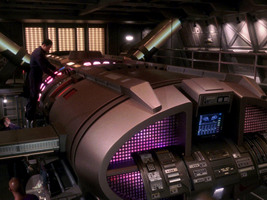
 Warp core in ENT: "Cold Front"
Warp core in ENT: "Cold Front"